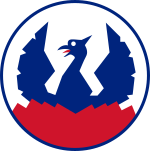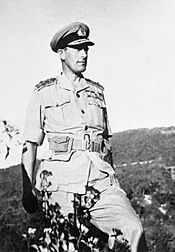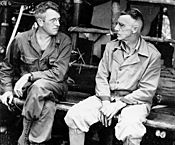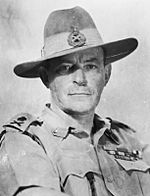South East Asia Command facts for kids
Quick facts for kids South East Asia Command |
|
|---|---|

Insignia of the South East Asian Command
|
|
| Active | 1943–1946 |
| Country | |
| Type | Command |
| Garrison/HQ | Kandy, British Ceylon |
| Insignia | |
| Flag |  |
The South East Asia Command (SEAC) was a special group created during World War II. Its main job was to lead all the Allied military operations in the Southeast Asian part of the war. This included land, sea, and air forces from different countries.
Contents
History of SEAC
How SEAC Was Set Up
At first, General Sir Archibald Wavell was in charge of Allied forces in this area. But his command, called ABDACOM, ended after Singapore and the Dutch East Indies were captured.
In August 1943, the Allies decided to create a new, combined command. This new group was called the South East Asia Command (SEAC). Its goal was to lead all the air, sea, and land operations in the region.
Winston Churchill, the British Prime Minister, chose Admiral Lord Louis Mountbatten to be the Supreme Allied Commander for Southeast Asia. An American general, Joseph Stilwell, became his deputy (second-in-command).
Mountbatten arrived in India in October 1943. SEAC officially started its work in Delhi on November 15, 1943. Later, in April 1944, SEAC's main office moved to Kandy in Ceylon (now Sri Lanka).
War Strategy in Southeast Asia
When World War II started, the Allies decided to focus on defeating Nazi Germany first. This meant that the war against Japan in Asia was not the main priority at the beginning. Major attacks in Asia were planned for later, after Germany was expected to be defeated.
The Allies also focused a lot on the Central Pacific and Southwest Pacific areas. These areas were seen as the fastest way to attack Japan directly. So, the Southeast Asia area, along with China, became less important compared to the Pacific.
Some people felt that SEAC was mainly about getting back colonial lands. The British seemed very interested in freeing their own Asian colonies. This sometimes made the Americans want to keep their distance from SEAC's political goals.
What SEAC Did
At first, SEAC was in charge of military operations in India, Burma, Ceylon, Malaya, and northern Sumatra. It also planned attacks on Siam (Thailand).
When Japan surrendered on August 15, 1945, SEAC's area grew. It then included the rest of the Dutch East Indies and the southern part of French Indochina.
The way SEAC was organized was often complex. Ideally, there would be a main commander for land, sea, and air forces under the Supreme Commander. This happened for the navy and air forces. But the British 11th Army Group only controlled British land forces.
American and Chinese forces, led by General Stilwell, reported directly to the Supreme Commander. This was because Stilwell did not want to work under the British 11th Army Group commander.
The air forces were also combined. The British RAF Third Tactical Air Force and the American USAAF Tenth Air Force worked together. They were later called Eastern Air Command. The navy was mostly British, led by Admiral Sir James Somerville.

Things became clearer in late 1944 after General Stilwell returned to Washington. His role was split among three people. Lieutenant General Raymond Wheeler became the Deputy Supreme Allied Commander for Southeast Asia.
The 11th Army Group was renamed Allied Land Forces South East Asia (ALFSEA). It was led by Lieutenant-General Oliver Leese. The American and Chinese troops were eventually moved to the China Theatre.
In February 1945, Air Marshal Keith Park became the Allied Air Commander for SEAC. He stayed in this role until the war ended.
After most of Burma was taken back, SEAC started planning to free Malaya. However, the war ended suddenly when atomic bombs were used on Japan.
After the War

After Japan surrendered, SEAC's job changed. It was no longer about fighting. Instead, it focused on helping to govern the areas and bring back order. Its area also grew to include more parts of the Dutch East Indies and southern French Indochina.
SEAC became responsible for over 128 million people. Many of them were still held by Japanese forces. This made SEAC's job very difficult. Western governments also wanted SEAC to help bring back the old colonial governments. But in many places, local people wanted their own independence.
Some Japanese soldiers who had been guarding prisons became prisoners themselves. The British put them to work cleaning and repairing things. There were sometimes difficult situations involving former Japanese soldiers. However, there were also efforts to help Japanese civilians go back home.
There were big food shortages everywhere. During the war, the Japanese military had taken a lot of food. This made people hide food or stop growing as much rice. Many people moved to cities, hoping to find more food. In some areas, over 20% of children were underweight or malnourished.
The British tried to bring in food, but it was hard to distribute it. Prices went up, and a black market for military food appeared. Money problems got worse when the British stopped using the Japanese wartime currency. Many workers in Singapore went on strike.
British Commonwealth troops were sent to the Dutch East Indies (Indonesia) and French Indochina. Their job was to help the old colonial powers return. Military rule was set up in Burma, Malaya, Singapore, and British Borneo. One Japanese unit in Borneo refused to surrender until November 1945.
Thailand, which had been an ally of Japan, quickly became independent again. It also restarted its ties with Western countries.
Because there weren't enough Allied soldiers, some Japanese soldiers who had surrendered were used to help. The Allies found that local nationalist groups in Indochina and Indonesia were strong and well-organized. These groups wanted their countries to be free.
Indonesian Fight for Freedom, 1945–46
In Indonesia, local leaders declared the Dutch East Indies an independent republic. This happened with help from armed groups that the Japanese had trained. The British wanted the Dutch government to return. They helped a small Dutch military group.
However, British troops soon faced more and more conflict with the Indonesian nationalists. The nationalists attacked Japanese soldiers who were waiting to go home, trying to take their weapons. A British officer, A. W. S. Mallaby, was killed while trying to get the nationalists to give up their weapons.
Because of this, on November 10, 1945, British forces attacked the city of Surabaya. This led to a very bloody fight called the Battle of Surabaya. The city was secured later that month. The battle for Surabaya was one of the toughest fights in the Indonesian National Revolution (1945–49). However, the British did not want to use too many of their soldiers to help the Dutch. So, they eventually left Indonesia.
SEAC Closes Down
As 1946 continued, SEAC finished its last tasks. Its second and final commander was Lieutenant-General Montagu Stopford. SEAC was officially closed down in November 1946. It was decided that a combined command was no longer needed in the area.
See also
- Radio SEAC


